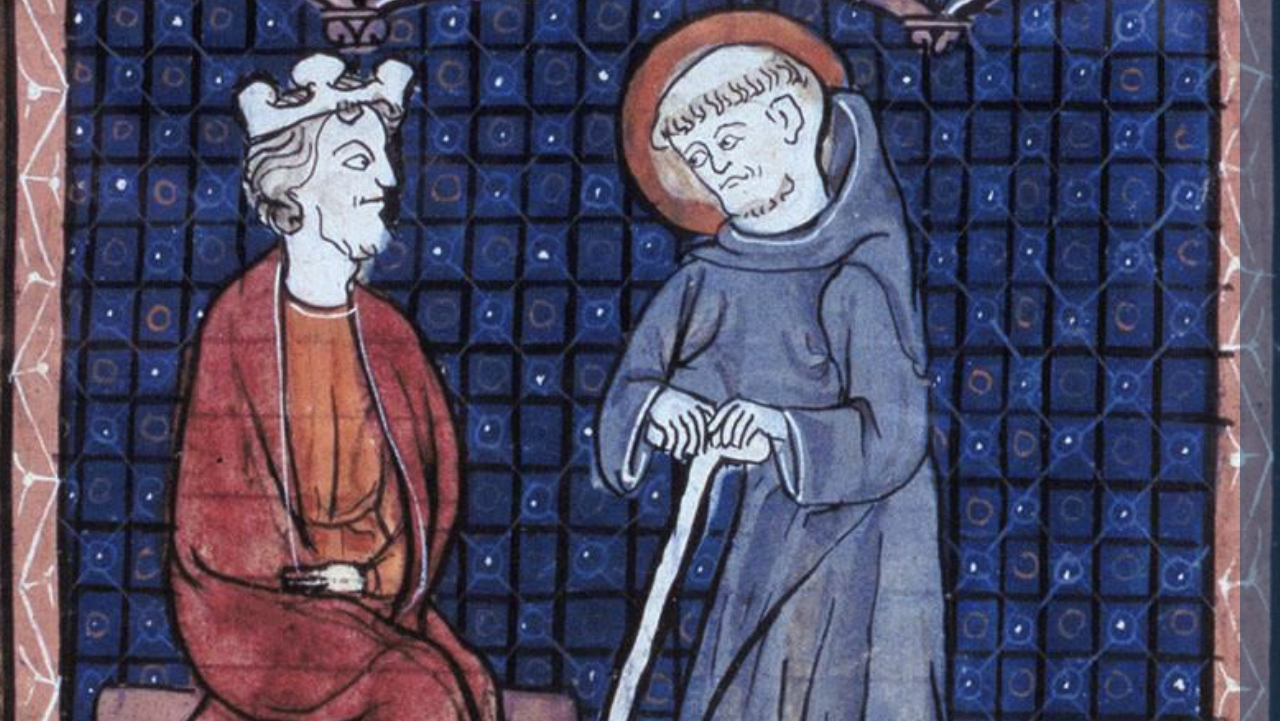Cheers to St Patrick
by Erin Doom
Feast of the Uncovering of the Precious Cross and the Precious Nails by Empress Saint Helen in Jerusalem
Anno Domini 2021, March 6

St Patrick with the King of Ireland (13th century)
1. Bible & Fathers: “The Breastplate” by St. Patrick the Enlightener of Ireland
2 John 1:1-13:
The elder to the elect lady and her children, whom I love in the truth, and not only I but also all who know the truth, because of the truth which abides in us and will be with us forever:
Grace, mercy, and peace will be with us, from God the Father and from Jesus Christ the Father's Son, in truth and love.
I rejoiced greatly to find some of your children following the truth, just as we have been commanded by the Father. And now I beg you, lady, not as though I were writing you a new commandment, but the one we have had from the beginning, that we love one another. And this is love, that we follow his commandments; this is the commandment, as you have heard from the beginning, that you follow love. For many deceivers have gone out into the world, men who will not acknowledge the coming of Jesus Christ in the flesh; such a one is the deceiver and the antichrist. Look to yourselves, that you may not lose what you have worked for, but may win a full reward. Anyone who goes ahead and does not abide in the doctrine of Christ does not have God; he who abides in the doctrine has both the Father and the Son. If anyone comes to you and does not bring this doctrine, do not receive him into the house or give him any greeting; for he who greets him shares his wicked work.
Though I have much to write to you, I would rather not use paper and ink, but I hope to come to see you and talk with you face to face, so that our joy may be complete.
The children of your elect sister greet you. Amen.
Every year for the last twelve years at the Feast of St Patrick, we have prayed The Lorica attributed to St Patrick. Lorica is Latin for “Armor” or “Breastplate.” It is an Irish prayer or hymn that replaced pagan charms when the Irish converted to Christianity, typically focused on invoking protection from dangers to body and soul. It’s an amazing prayer and I encourage you to pray it! Here is the text. We have also, on occasion, read the Hymn of St Patrick by St. Secundinus. You can read that hymn, in both English and Latin here (I included the Latin so you could see the abecedarian character of the hymn).
2. Books & Culture: “Audite Omnes: The Works of St Patrick” by Erin Doom
Here is a short essay review of one of the earlier English translations of the works of St. Patrick.
3. Essays et al: “St Patrick: Confession & Confession” by Fr Gabriel Rochelle
And here is an excerpt from the lecture Fr. Gabriel presented last year at the Feast of St Patrick:
Confession is not oriented in the same way as we might expect from the austerity of the Penitentials that dominated so much of later Christianity in the islands. It may, in fact, be misnamed. Other penitential rituals did not contain penances as do the Irish Penitentials. It is thought that the penances, and their severity, entered the Irish tradition through the Druids. Other rules such as that of John Cassian, Pachomius, and Basil all refer to the practice of confession with no penance attached.
Although Patrick doesn’t write against the practice, Patrick’s confession has none of this notion of severe penance in it. It is misnamed if you’re looking for this heightened penitential sense. However, confession has another meaning as a positive act, as a practice of giving thanks for your aliveness, looking around and enjoying your specific place in the world, and increasing your humility before others. That’s the scope of Patrick’s confession. Sure, Patrick is aware of his inadequacies, failures, and trespasses, but these things do not dominate his confession. He loved the Irish people among whom he served, though he was not himself Irish. The hallmarks are joy, praise, thanksgiving, and a sense of connectedness to the earth and its creatures. No wonder the Breastplate is credited to him; it’s full of these same hallmarks.
Patrick’s confession is more a paean of praise to the Holy Trinity and of God’s mercy upon His people; it is a clinging to the work of Christ in cross and resurrection, the Christ who has brought all people to the presence of the Father, as in John’s Gospel: “And I, when I am lifted up, will draw all people to myself” (John 12:32; John’s verse is a double entendre: it means both the lifting up on the cross and the lifting up in exaltation, which is John’s approach to the resurrection). Christ is like a magnet or like YHWH, who at Hosea 2 says of Israel, “I will allure her,” drawing Israel back to Himself like a lover.
Contribute to Cultural Renewal by Sharing on Your Preferred Platform
In an isolating secularized culture where the Church's voice is muffled through her many divisions, Christians need all the help they can get to strengthen their faith in God and love toward their neighbor. Eighth Day Institute offers hope to all Christians through our adherence to the Nicene faith, our ecumenical dialogues of love and truth, and our many events and publications to strengthen faith, grow in wisdom, and foster Christian friendships of love. Will you join us in our efforts to renew soul & city? Donate today and join the community of Eighth Day Members who are working together to renew culture through faith & learning.








